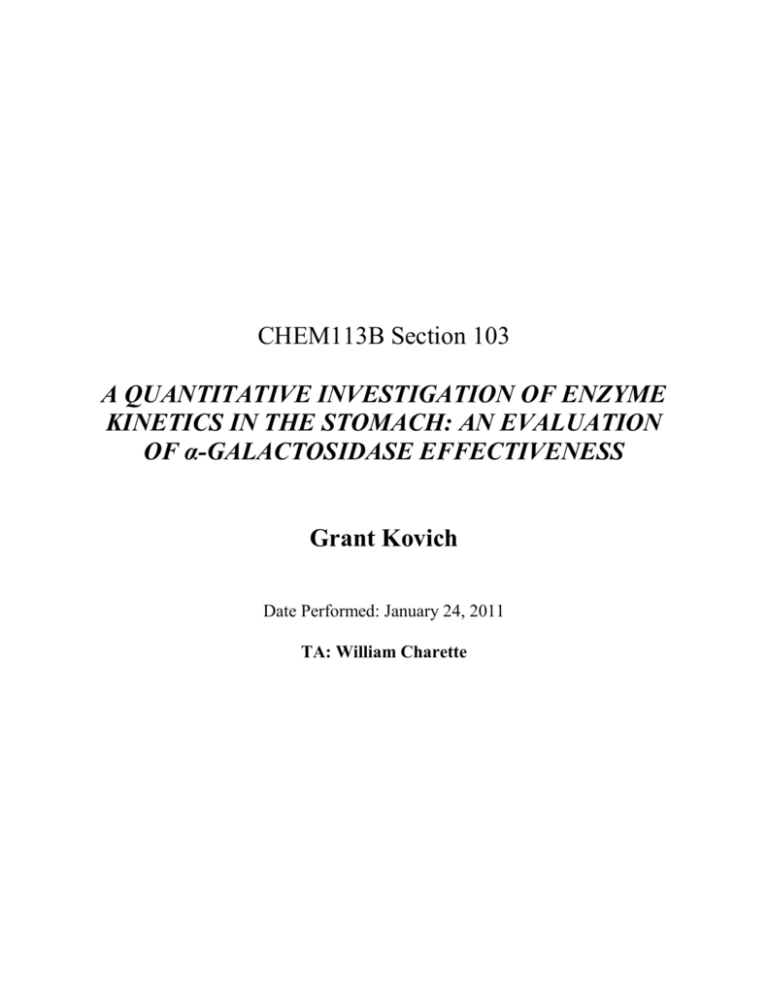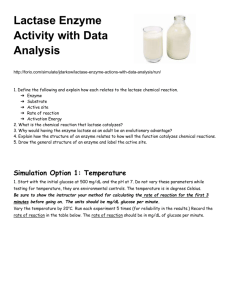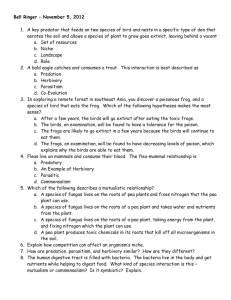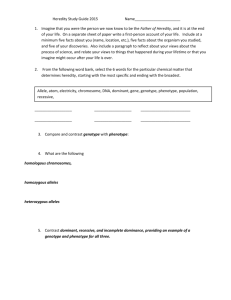
CHEM113B Section 103
A QUANTITATIVE INVESTIGATION OF ENZYME
KINETICS IN THE STOMACH: AN EVALUATION
OF α-GALACTOSIDASE EFFECTIVENESS
Grant Kovich
Date Performed: January 24, 2011
TA: William Charette
Introduction
On the surface, the average human being only observes a few reactions taking place—
respiration, heartbeat, nerve impulses, muscle contractions. Beneath the most superficial layer of
the human body, the skin, lies a multitude of chemical reactions necessary for life to exist. These
chemical reactions are microscopic, and are never seen or even noticed by a human. However,
the processes that are performed “behind the scenes” are what truly make the human body
function.
When a chemical reaction occurs, it does not occur all at once, but rather in a series of
steps. The rate at which a reaction occurs is directly dependent upon the concentration of the
reactants. The higher concentration of reactants that is present, the faster the reaction will
proceed, which can be shown linearly.1 There is a specific energy that is required for a reaction
to occur, known as the activation energy. If the products cannot overcome this energy barrier,
then the reaction will not occur. After the activation energy has been reached, the reaction will
proceed in a series of steps. These steps are known as reaction mechanisms, and can vary in
length and speed. Ultimately, the slow step of a reaction determines the rate at which the
reaction proceeds. Regardless of which step determines the rate of the reaction, the rate is also
dependent on environmental factors such as pH and temperature.2 Most reactions will occur
more rapidly at higher temperatures.
1
Ault, Addison. "An Introduction to Enzyme Kinetics." Journal of Chemical Education 51.6
(1974): 381-86. Print
2
Brown, Theodore L., Harold E. LeMay, and Bruce E. Bursten. "Chemical Kinetics."
Chemistry: The Central Science. Upper Saddle River, NJ: Pearson Prentice Hall, 2009. 608-12.
Print.
2
Many of these reactions involve or require enzymes. Enzymes, consisting of complex
proteins produced by specific body cells, help speed up chemical reactions.3 Within the human
body, one must have an immediate response to counteract any problems and to keep the body
functioning properly, thus enzymes are essential for life. Without enzymes, most of the reactions
that keep the body functioning would not be able to happen, leaving the body susceptible to
damage or complications. The rate of a chemical reaction catalyzed by an enzyme is directly
proportional to the total enzyme concentration.4 Just as a higher concentration of reactants leads
to a faster rate of reaction, a higher concentration of enzymes will allow for faster catalysis, thus
producing a faster reaction rate. In addition, enzymes also affect the graphical interpretation of a
reaction rate by displaying logarithmic behavior, rather than a linear trend.1
As previously stated, without enzymes, the body would not be able to function at an
optimal level, creating problems ranging from easily curable to very severe. One common
problem that almost all human beings experience is flatulence. Most individuals have a notion
that when they eat a particular type of food, they will experience gas and bloating during
digestion, which is correct. However, the reason behind gas is not due to the assumed aftereffect of eating a certain food, but rather a biochemical reason that originates in the stomach.
Flatulence occurs in the stomach and bowels of a human, and over the course of an average day,
up to half a liter of flatulence can be produced.3 The main biochemical reason behind flatulence
is the lack of an enzyme. Many of the foods that are known as flatulence causing contain
indigestible sugars known as oligosaccharides. The human body lacks the necessary enzyme to
break down these sugars, α-galactosidase.3 As a result, bacteria rid the stomach of these sugars
3
Keiser, Joseph T. Chemistry 113B Laboratory Manual. Hayden-McNeil, Plymouth, MI, 2011,
pages 6-1—6-6.
4 Shaw, William. "The Kinetics of Enzyme Catalyzed Reactions." Journal of Chemical
Education 34.1 (1957): 22-25. Print.
3
through fermentation, releasing the smelly gas known as flatulence. The release of flatulence
can be prevented, however, by consuming an enzyme supplement, Beano®, that contains αgalactosidase (Fig 1).
Oligosaccharides
H2O
CH2OH
O
HO
H
H
OH
α-galactosidase
CH2OH
CH2OH O
CH2OH
OH
H
H
OH
Galactose
+
H
O
H
H
O
O H
H
H
H
H
O
H
H
OH
OH
Lactose
H2O
CH2OH
OH
O
O
H
OH
H
H
OH
β-glucose
H
H
OH
H
Lactase
CH2OH
H H
H
OHCH OH
2
H
OH
Fructose
Figure 1. Breakdown of oligosaccharides with the assistance of the enzyme α-galactosidase.
The reaction yields sucrose which can then be broken down into β-glucose and sucrose.3
It can be seen that upon breakdown of an oligosaccharide, galactose and lactose are
formed, which can then produce β-glucose and fructose. β-glucose levels can then be measured
by a glucometer, which measures the concentration of glucose present in a solution in mg/dL. A
glucometer works by placing the sample on the test strip, which then flows up a semi-permeable
4
membrane.5 When the sample is completely absorbed, the glucometer can read it and deliver an
accurate representation of how much glucose is present (Fig 2).
Figure 2. Diagram of a glucometer, which works by absorbing a
glucose solution and then delivering it to the glucometer where it can
be read.5
The purpose of this experiment was to determine whether or not the enzyme αgalactosidase is effective in catalyzing the reaction of raffinose sugars. raffinose sugars are a
type of oligosaccharide found in legumes, such as peas and beans.6 The experiment was
intended to mirror the conditions of the human stomach, where these reactions occur frequently.
Since raffinose sugars cannot be broken down by the body, flatulence almost always occurs.
However, this experiment sought to prove whether or not an over the counter drug, Beano®, is
effective at breaking down raffinose sugars and preventing flatulence. We believe that αgalactosidase will prevent flatulence by catalyzing the breakdown of raffinose sugars for
5
Okazaki, Robert. "Membrane Transport." Weber State University. Web. 17 Feb. 2011.
<http://faculty.weber.edu/nokazaki/Human_Physiology/Laboratory/Diffusion%20and%20Osmos
is.htm>.
6 Carlsson, Nils-Gunnar, Hasse Karlsson, and Ann-Sofie Sandberg. "Determination of
Oligosaccharides in Foods, Diets, and Intestinal Contents by High-Temperature Gas
Chromatography and Gas Chromatography/Mass Spectrometry." Journal of Agricultural and
Food Chemistry 40.12 (1992): 2404-412. Print.
5
multiple reasons. Beano® has been a trusted medication to relieve gas and bloating for a long
time, proving its reliability. Also, enzymes are specific proteins that can only catalyze a certain
reaction, which leads us to believe that α-galactosidase is the only enzyme that is able to break
down raffinose sugars. My prediction also follows prior scientific data, in that if there is a
greater concentration of the reactant present added to the enzyme, the reaction will proceed at a
faster rate.7 If this is true, the reaction will catalyze faster when there is a higher concentration of
raffinose sugars, while the concentration of glucose will increase more rapidly.
Procedure
Experimentation was done in a controlled environment in which safety regulations were
followed at all times. A teacher’s assistant, who helped with problems or concerns, conducted
supervision. Prior to performing the experiment, each glucometer had to be calibrated so that it
could deliver accurate readings. This was done by preparing five glucose solutions of known
concentrations, and using them to determine the accuracy of the glucometer readings. Samples
were made by dissolving Dextrose in distilled water and allowing them to react in a refrigerator
at 20ºC so that the solution was able to reach equilibrium between α and β glucose (Fig 3).
When the reaction concluded about twelve hours later, the concentration of β-glucose could be
measured by the glucometer to determine the accuracy of the instrument.
7
"Effect of Temperature on Enzyme Activity." Brooklyn College: The City University of New
York. Web. 17 Feb. 2011.
<http://academic.brooklyn.cuny.edu/biology/bio4fv/page/enz_act.htm>.
6
Amount of Dextrose
Dissolved (g)
0.1
Amount of ddH2O Used as
Solvent (mL)
100
Final Concentration of Prepared
Solution (mg/dL)
100
0.2
100
200
0.3
100
300
0.4
100
400
0.5
100
500
Figure 3. Table of prepared glucose solutions used to calibrate glucometer prior to
experimentation.
Upon calibration of the glucometer, experimentation proceeded by testing the effectiveness of αgalactosidase in different concentrations of pea extracts. Pea extracts were used in this
experiment due to their high concentration of raffinose sugars. 100μL of α-galactosidase was
added to 10mL of each concentration of pea extract, 100%, 50%, and 25%. A stir plate was used
throughout experimentation to ensure that the enzyme would be adequately present throughout
the entire sample of pea extract. The glucose concentration was determined in two-minute
intervals of ten minutes by dipping the tip of a glucose test strip into the beaker containing the
enzyme and pea extract, and taking a reading using the calibrated glucometer. Temperature was
held constant at 24ºC during experimentation. After completing this portion of the experiment,
the impact of pea extract concentration on enzyme effectiveness could be determined.
In order to further understand how enzymes work, another factor was presented that
could potentially change the rate at which the reaction occurred—temperature. It can be said that
the rate of a reaction without a catalyst will increase as temperature increases, so this portion of
the experiment was performed to determine whether or not an enzyme would work more
effectively at a higher temperature. The temperature-dependent experimentation was performed
using the 50% pea extract. The procedure was fairly identical to the previous procedure with one
7
exception: the extract was contained within a water bath kept at 10ºC for one trial and 40ºC for
the second trial. The results of the enzyme effectiveness on pea extract catalysis were then
compared at 10ºC, 24ºC, and 40ºC.
Results
50% Pea Extract, 10ºC
100% Pea Extract, 24ºC
Time
(min)
0
2
4
6
8
10
Time
(min)
0
2
4
6
8
10
Glucose Concentration
(mg/dL)
65
191
211
229
217
208
50% Pea Extract, 40ºC
50% Pea Extract, 24ºC
Time
(min)
0
2
4
6
8
10
Time
(min)
0
2
4
6
8
10
Glucose Concentration
(mg/dL)
21
157
174
189
180
197
Glucose Concentration
(mg/dL)
26
257
265
268
274
239
Figure 4. Glucose concentration data
obtained from reaction of 10 μL
α-galactosidase with 100 mL of varying
concentrations of pea extract. Data was
recorded in two minute increments for a
total reaction length of ten minutes.8
25% Pea Extract, 24ºC
Time
(min)
0
2
4
6
8
10
Glucose Concentration
(mg/dL)
26
295
287
301
290
284
Glucose Concentration
(mg/dL)
Lo*
224
223
235
235
230
8
Charette, William. Penn State University
Chemistry 111/113 Lab Notebook. Hayden
McNeil, Plymouth, MI, 2009, pages 41-42.
8
Glucose Concentration (mg/dL)
100% Pea Extract, 24ºC
250
200
150
100
50
0
0
2
4
6
Time (min)
8
10
12
Figure 5. Graphical interpretation of α-galactosidase effectiveness of
synthesizing raffinose sugars in 100% pea extract at room temperature.
Glucose Concentration (mg/dL)
50% Pea Extract, 24ºC
250
200
150
100
50
0
0
2
4
6
Time (min)
8
10
Figure 6. Graphical interpretation of α-galactosidase effectiveness of
synthesizing raffinose sugars in 50% pea extract at room temperature.
9
12
Glucose Concentration (mg/dL)
25% Pea Extract, 24ºC
300
250
200
150
100
50
0
0
2
4
6
Time (min)
8
10
12
Figure 7. Graphical interpretation of α-galactosidase effectiveness of
synthesizing raffinose sugars in 25% pea extract at room temperature.
The Effect of Temperature on αgalactosidase Effectiveness
Glucose Concentration (mg/dL)
350
300
250
200
10ºC
150
24ºC
40ºC
100
50
0
0
2
4
6
Time (min)
8
10
12
Figure 8. Graphical comparison of α-galactosidase effectiveness of synthesizing raffinose sugars
in 50% pea extract at various temperatures.
10
Discussion
One of the most observable characteristics of the data is that it is not linear in nature, but
rather nonlinear. The experimentally determined data goes against previously mentioned
research that described the relationship between increased reactant concentration and a faster
reaction rate linearly. It can be seen that when the pea extract is of a higher concentration, the
reaction occurs faster, which in turn produces more glucose. A higher initial concentration of
glucose signifies a faster initial reaction rate. It is interesting to note the time at which each
reaction comes to completion. At a certain point, there will not be any more reactant left to react,
and the level of glucose will remain fairly constant. However, the concentration of glucose did
not stay exactly the same after the reaction completed, which may be due to the accuracy of the
glucometer. The point is, however, at a certain point the reaction will come to completion.
It can also be noted that the reactions with a higher concentration of pea extract produce a
higher concentration of glucose. This makes sense because if there is a higher concentration of
reactant that can react, there will be a higher concentration of product produced. Therefore, the
reactions that have a higher concentration of pea extract have a higher concentration of glucose
when they come to completion.
Upon comparison of experiment data at different temperatures, when pea extract
concentration was held constant at 50%, a relationship can be seen between the temperature at
which the reaction took place, and the rate at which the reaction occurred. However, these data
do not agree with scientific literature stating that a higher temperature results in a faster reaction.
It can be seen in the data that the fastest reaction rate occurred when the reaction took place at
10ºC, which was the coldest temperature of the experimental series. At colder temperatures,
molecules move slower and as a result, fewer collisions between molecules occur. As such, it
11
follows that the reaction would proceed slower due to the lessened frequency of molecules
colliding allowing for a reaction to occur. While there was an enzyme used during this
experiment that was supposed to increase the rate of reaction, the enzyme was present in all trials
in the same amount and concentration. Therefore, the temperature is solely dependent on the
rate of reaction in this case.
There was an interesting trend noted, however, that involved the amount of glucose
produced by the reaction. The concentration of pea extract was kept constant at 50% while only
temperature was changed, but the amount of glucose produced was different for each reaction. If
there exists a relationship between temperature and reaction rate, it would make sense for the
reaction to proceed faster, but since the concentration was kept constant, all three reactions
should have ended with the same concentration of glucose. The slope of the data points should
have been the only thing that changed.
It is interesting to note that the reaction that took place at the highest temperature ended
up having the slowest reaction rate, and that the data was essentially the opposite of what was
expected to occur. The reason behind this irregularity would be interesting to examine since the
concentration and volume of α-galactosidase and pea extract was kept constant throughout each
trial of the experiment.
The first set of experimental trials featured data that was consistent with previous
experiments—the higher concentration of a reaction that is present in a reaction, the higher the
concentration of reactants will be—regardless if there in an enzyme. However, the second set of
experimental trials proved to be the complete opposite of what was expected. As a result of this,
there are sources of error that may have caused these irregularities. When performing the
experiment, we were given each solution in a bottle that was appropriately labeled. We did not
12
have to prepare any solutions for the experiment. With that being said, there may have been
errors in solution preparation, and the concentration may have been different then what was
actually presented to us. Also, the pipettes that were used in this lab were not volumetric
micropipettors that are used in microbiology. Those pipettors have the ability to absorb and
release a specific volume of liquid. The pipettes that were used in this lab were large drop
pipettes. These pipettes did not have a specific volume, and addition of solution was done by
droplets. The volume of a specific droplet was unknown, because it could vary based on many
factors including the presence of air bubbles, and the way in which the pipette was being held
upon release of the solution. Another possible source of error could be the temperature at which
each reaction took place. Temperature can easily be influenced by external factors, and although
the temperature may have been where it was supposed to be at the beginning of the reaction, it
may have easily changed throughout the experimentation process, which may have skewed
results. A final possible source of error may have been the pH at which the reaction took place.
Enzymes work best under a specific pH, and in this particular reaction, the enzyme would have
worked best in a solution that was similar to that of the human stomach. The pH of the
environment is not the only reason why the results differed from expectations, but if the
experiment would have taken place at the appropriate pH, better, more accurate results may have
been obtained.
Conclusion
The purpose of this experiment was to determine whether or not reactant concentration
and temperature of the environment at which a reaction took place would impact the rate of a
reaction. It was previously believed that if reactants were of a higher concentration, the product
would be present in a higher concentration after the reaction came to completion, and that the
13
rate of reaction would increase as reactant concentration increased. Also, it was thought that if a
reaction took place at a higher temperature, it would have a higher reaction rate due to the
increased number of collisions between reactant molecules. The first hypothesis was proven to
be true, because it was seen that the rate of reaction increased as the concentration of reactant
increased. However, the resulting data from the second hypothesis was not what was expected;
in fact it was exactly the opposite. The reaction that took place at the coldest temperature had
the fastest reaction rate, while the reaction that took place at the warmest temperature had the
slowest reaction rate. Also, the second set of reactions had different concentrations of product,
which was interesting since that the concentration of the reactant was kept the same. The central
idea that can be retrieved from this experiment is that certain reactions cannot take place unless
an enzyme is in place, and this was proven due to the fact that glucose was produced from the
breakdown of raffinose sugars by α-galactosidase. However the rate at which the reaction took
place was dependent on the concentration of the pea extract and the temperature at which the
reaction took place, which we feel was the main point of this reaction. The concept of enzymes
and how they work could easily be observed, but the data collected was not what was expected.
References
1. Ault, Addison. "An Introduction to Enzyme Kinetics." Journal of Chemical Education 51.6
(1974): 381-86. Print.
2. Brown, Theodore L., Harold E. LeMay, and Bruce E. Bursten. "Chemical Kinetics."
Chemistry: The Central Science. Upper Saddle River, NJ: Pearson Prentice Hall, 2009.
608-12. Print.
3. Keiser, Joseph T. Chemistry 113B Laboratory Manual. Hayden-McNeil, Plymouth, MI, 2011,
pages 6-1—6-6.
14
4. Shaw, William. "The Kinetics of Enzyme Catalyzed Reactions." Journal of Chemical
Education 34.1 (1957): 22-25. Print.
5. Okazaki, Robert. "Membrane Transport." Weber State University. Web. 17 Feb. 2011.
<http://faculty.weber.edu/nokazaki/Human_Physiology/Laboratory/Diffusion%20and%2
0Osmosis.htm>.
6. Carlsson, Nils-Gunnar, Hasse Karlsson, and Ann-Sofie Sandberg. "Determination of
Oligosaccharides in Foods, Diets, and Intestinal Contents by High-Temperature Gas
Chromatography and Gas Chromatography/Mass Spectrometry." Journal of Agricultural
and Food Chemistry 40.12 (1992): 2404-412. Print.
7. "Effect of Temperature on Enzyme Activity." Brooklyn College: The City University of New
York. Web. 17 Feb. 2011.
<http://academic.brooklyn.cuny.edu/biology/bio4fv/page/enz_act.htm>.
8. Charette, William. Penn State University Chemistry 111/113 Lab Notebook. Hayden McNeil,
Plymouth, MI, 2009, pages 41-42.
15









